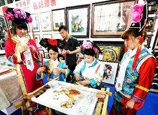
Louis Vuitton, Gucci, Dolce&Gabbana and many other top fashion brands are famous for their eye-catching logos. For most Chinese consumers, printed logos on bags, shirts or a metal buckle logo on a belt were how people learned about these big brands. However, the trend of the big logo has been fading away in recent years.
"In 2005 and 2006, Prada and D&G were still selling products with big logos as their leading seasonal trend but coming to 2008 and 2009, one of my classmates in college already produced a thesis on how big logos in design were on their way out," said Jiang Zhuo, a designer from the Chinese brand Exception de Mix Mind.
Although the fashion winds of more low-profiled designs with smaller logos began blowing several years ago in Europe and the US, it has only recently swept across China.
Fad fading away
At the end of May, Patrizio di Marco, CEO of Gucci, said in an interview with Bloomberg Television that the logo era has gone forever. Almost at the same time, Coach renewed their stores internationally and released the information that they are going to reduce its logo products from 30 and 40 percent to 20 percent in the coming years.
A report on the 2012 Chinese market for luxury products by Fortune Character Institute, a research and consulting organization based in Beijing, published corresponding results, suggesting Chinese consumers' attitudes toward big logos had changed over the years.
Public acknowledgement of logos has been through six phases, from no basic understanding of luxury trademarks at all to being in love with or obsessed by products with big logos. Later, the public disliked big logos and finally began preferring things with no visible logos at all. The report also indicated that the more the consumer earns, the less likely they are to select products with big logos.
According to Zhou Ting, dean of Fortune Character Institute, the information that many brands have released to media about their future strategic plans of reducing big logo products was based on the advice given by the institute's report. Chinese people's purchasing power has made their aesthetics more valuable to the luxury brands.
"The Chinese consumers are supporting the luxury industry worldwide," said Zhou, adding that not only is the Chinese market the biggest in the world now, but also Chinese consumers account for 50 to 70 percent of consumption of luxury products in many foreign markets.
A similar finding by Bain&Company, an industry consulting firm, also concluded that Chinese customers still purchase 25 percent of the goods sold on the global luxury market in 2012.
Causes clarified
Zhou told the Global Times that two main causes contributed to the changes in preference. The first is that top brands like Gucci and LV have been expanding massively around China in the past two decades and are now recognized in third and fourth-tier cities as well as the big cities.
On one hand, counterfeit goods are everywhere, making products with big logos no longer a positive representation for the people who wear or carry them. For many customers, this reduces the value of the brand names.
For people who cannot afford luxury products, big logos suggest a gap between different classes, which further magnifies social problems and builds resentment.

















 Developer razes historic Guangzhou structures
Developer razes historic Guangzhou structures


![]()
